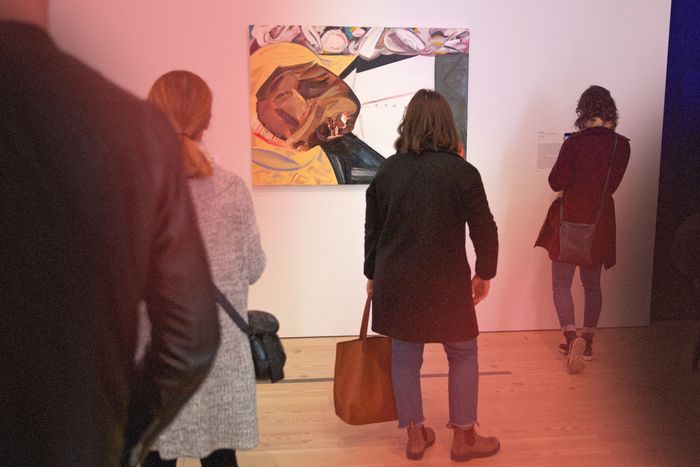
Before Dana Schutz’s Open Casket (2016) came to the Whitney Biennial, the painting was displayed nearly 4,000 miles away at a commercial gallery in Berlin. It was part of a solo exhibition titled “Waiting for the Barbarians,” some of whose works — the gallery noted — Schutz had created in response to the “increasingly blurred” lines between “fact and fiction” in American culture. This collection of works would “reflect real events.”
The painting, equally clinical and tempestuous, depicts Emmett Till. Factually, Emmett was 14 years old when he was brutally murdered in Mississippi in 1955. Factually, the child’s mother, Mamie Till-Mobley, then Mamie Till, had sent her son from Chicago to visit family in Money, Mississippi. Factually, Emmett was kidnapped. His mutilated body was later sent home to Chicago and displayed in an open casket to, as Till-Mobley told the press, “let the people see what I’ve seen.” Photographs of the young boy were published in Jet magazine, the Chicago Defender, and other Black-press outlets.
In the fiction of Schutz’s painting, we see a cropped, almost dronelike view into Emmett’s casket; thick layers of paint and cardboard construct the artist’s interpretation of his corpse, re-creating the deep cuts and lacerations in his flesh. In Schutz’s attempt to reflect reality, her own gestures bogart the image, reopening a decades-old wound without bringing a new dimension of understanding to it. After all, as Black folks, the facts of this image have always been inscribed into the fiber of our beings on American soil, whether we are conscious of it or not.
When Open Casket became the subject of protests and news coverage, Schutz explained the emotional impulse behind the painting. “The thought of anything happening to your child is beyond comprehension,” she said. “Their pain is your pain. My engagement with this image was through empathy with his mother.” I still think about her answer, and the many ways we have continued to experience the limits of empathy in the years since, through a cycle of violence, uproar, and the inevitable return to business as usual. Is empathy a retweet or a signal boost? A charitable donation? Exposure? A painting in a biennial? A black square? Who feels the weight of immeasurable loss, and who benefits? Who tells us what’s real?
In its original viewing in Berlin, the painting’s contemporaries all sold, but the artist held on to two works, including Open Casket. A fiction all her own.




